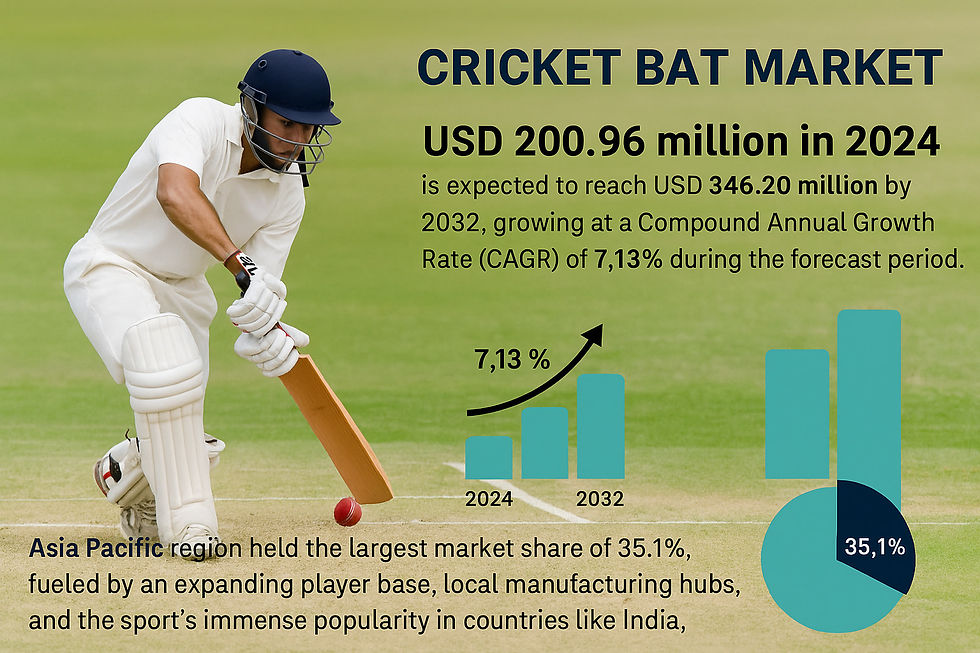Cricket Bat Market Ecosystem Mapping and Strategic Outlook
- Reddy S
- Aug 12
- 3 min read
According to Fortune Business Insights, the global cricket bat market size was valued at USD 200.96 million in 2024 and is projected to grow to USD 346.20 million by 2032, registering a robust CAGR of 7.13% during the forecast period. This market growth is fueled by the rising global popularity of cricket, increasing demand for premium-quality equipment, and the strong expansion of professional and amateur cricket leagues worldwide. In 2024, Asia Pacific dominated the market with a 35.1% market share, supported by a rapidly growing player base, thriving local manufacturing hubs, and the sport’s massive following in cricket-loving nations such as India, Pakistan, and Australia.

Request FREE Sample Copy of Cricket Bat Market Report: https://www.fortunebusinessinsights.com/enquiry/request-sample-pdf/cricket-bat-market-113141
Market Trends
Design Innovation & Sustainability
The market is witnessing a shift towards eco-friendly, recycled materials and advanced design features. Lightweight designs, better grip, and customizable features attract the younger generation and align with modern performance expectations.
Key Players
Kookaburra Sport Pty Ltd (Australia)
Grays International (U.K.)
Sommers (Australia)
KIPPAX WILLOW LIMITED COMPANY (U.K.)
Bradbury (Australia)
Blue Tongue Sports (Australia)
Adidas AG (Germany)
Stag Cricket (U.K.)
Salix Cricket Bat Co. Ltd. (U.K.)
Sareen Sports Industries (India)
Market Dynamics
Market Drivers
Rise of Domestic & International Cricket Leagues:
The global expansion of cricket leagues such as the Indian Premier League (IPL), Big Bash League (BBL), and The Hundred is boosting the demand for high-quality bats. The emergence of Major League Cricket in the USA further diversifies the consumer base.
Increased Investment in Sports Gear:
Consumers are investing more in customized, high-performance cricket equipment, with online platforms making these products more accessible. The influence of professional endorsements and player-specific bat models further drives premium bat sales.
Grassroots Participation Growth:
With growing cricket academies, school tournaments, and recreational play, demand is surging across both professional and amateur segments.
Market Restraints
High Cost of Premium Raw Materials:
English willow bats, known for their superior performance, are expensive due to limited availability and rising logistics costs. Kashmir willow alternatives do not always meet professional performance standards, limiting their adoption.
Market Opportunities
Smart Cricket Bats with Sensor Technology:
Tech-integrated cricket bats that track swing speed, impact force, and bat angle present a major opportunity. These innovations, coupled with partnerships with academies and leagues, can enhance training outcomes and appeal to tech-savvy athletes.
Segmentation Analysis
By Type
Wooden Bats (English & Kashmir Willow) dominate due to their performance and historical preference.
EVA Bats are gaining popularity for being lightweight, durable, and cost-effective, especially among beginners.
By End-user
Professional Players account for the highest revenue share due to demand for high-performance bats.
Amateur Players seek mid-to-premium range bats offering value and durability.
Recreational Players prefer budget-friendly options for casual play.
By Price Range
Mid-Range Bats led the market in 2024, appealing to a broad customer base.
Premium Bats are expected to grow fastest due to rising disposable income and preference for branded, endorsed equipment.
Budget Bats cater to beginners and recreational players in emerging markets.
Regional Insights
Asia Pacific
Leading the global cricket bat market, the region benefits from:
Strong cricket culture and grassroots support
Local manufacturing dominance (India produces 80% of protective gear globally)
Export networks to over 40 countries, including Europe and the Middle East
North America
Rapidly growing due to:
Technological innovation in bat manufacturing
Expanding cricket fan base and league formation (e.g., USA’s Major League Cricket)
Online sales channels and top-tier brand penetration
Europe
Europe, especially Germany and the U.K., is showing promising growth. Germany has expanded from 30 to over 400 cricket teams since 1988. Female participation and youth programs are also on the rise.
South America & Middle East & Africa
Growth is fueled by:
Increased women’s cricket in Brazil
Expansion of domestic tournaments and youth development programs
Competitive Landscape
Continuous Development and Innovation resulted in the Dominating Position of the Key Players in the Market
The global cricket bat industry is concentrated with key players such as Adidas AG, Kookaburra Sport Pty Ltd, Grays International, Bradbury, and KIPPAX WILLOW LIMITED COMPANY, which account for a significant market share.
Strategic Developments
June 2024: Kookaburra Sport Pty Ltd, a Melbourne based sports equipment and apparel company, launched 2024/25 cricket gear range, a collection that is set to transform the cricketing world. This collection includes variety of cricket bats
April 2024: GR8 Sports India Pvt Ltd, a producer of Kashmir Willow cricket bats, launched a bat made of Kashmir willow for Women’s International Cricket.
October 2023: Gray Nicolls, the well-known cricket brand and a manufacturer of rackets and cricket bats, unveiled a brand new cricket range for season 2022/23, which includes a couple of modern-day classics: the Predator and a modern twist of the bat.
The cricket bat market is set for steady growth through 2025 to 2032, backed by increasing cricket adoption across demographics, tech-integrated products, and rising sports investment globally. Companies focusing on sustainability, innovation, and partnerships are well-positioned to dominate this evolving landscape.







Comments